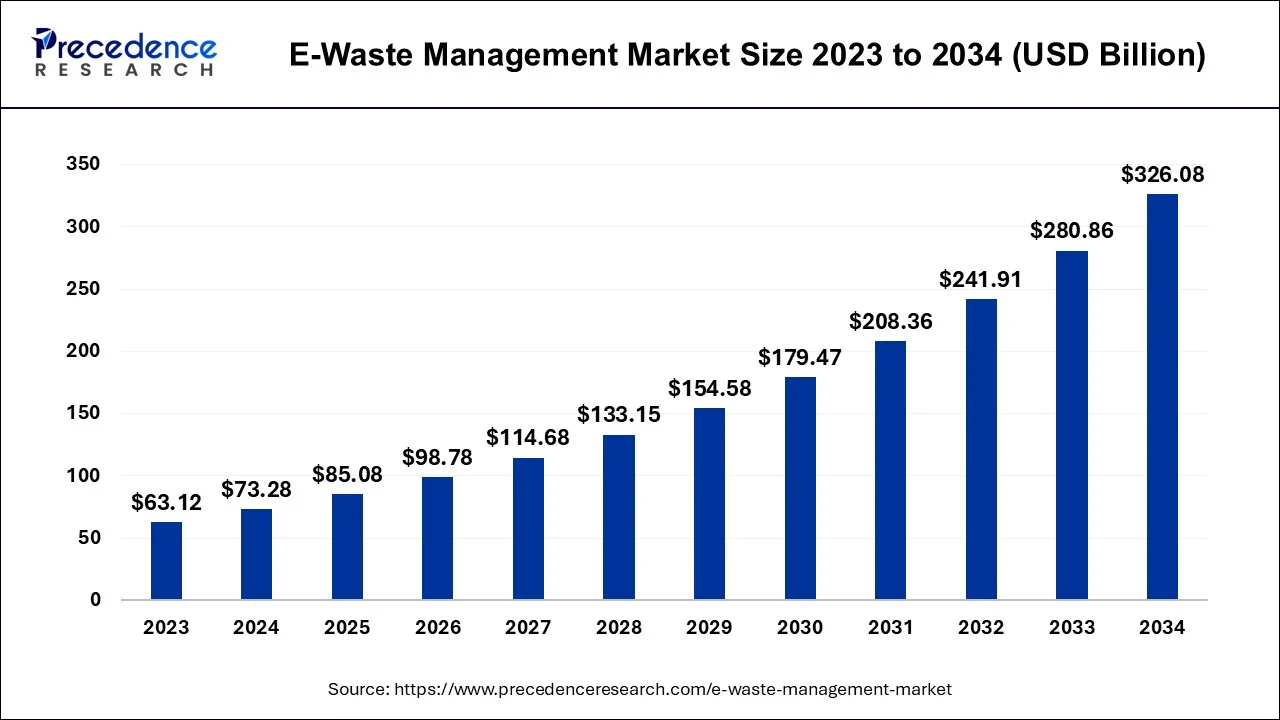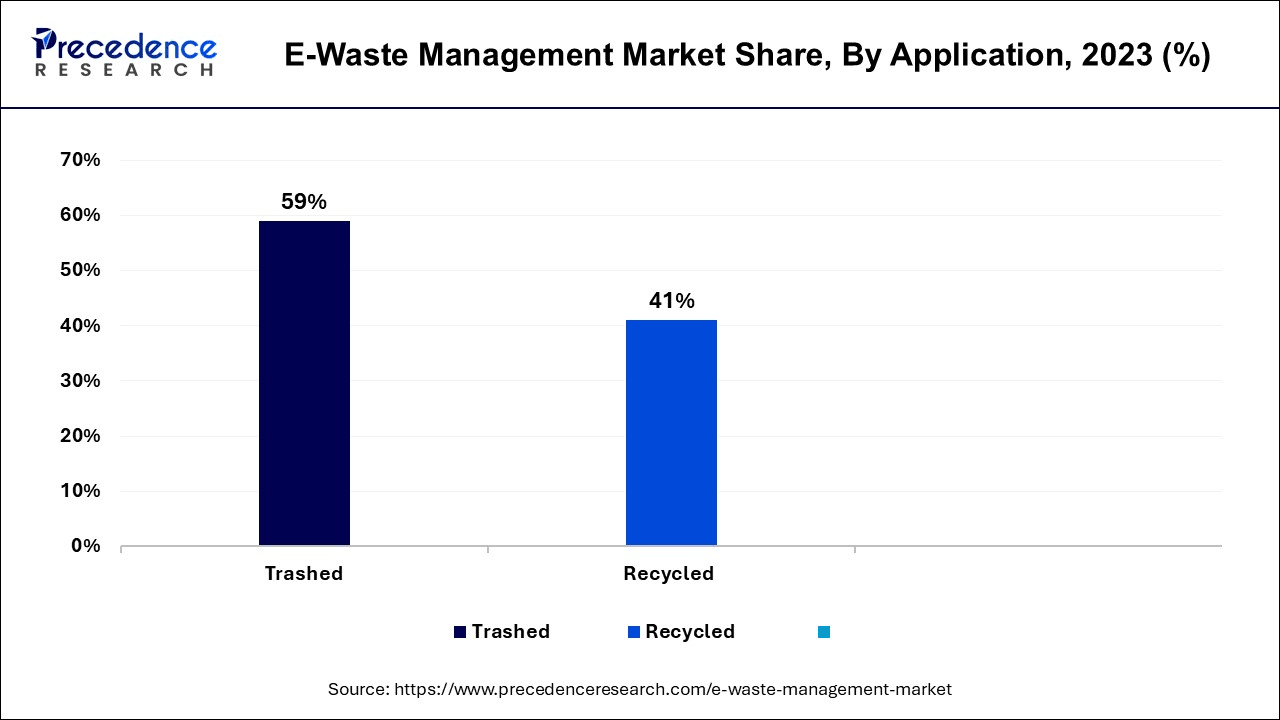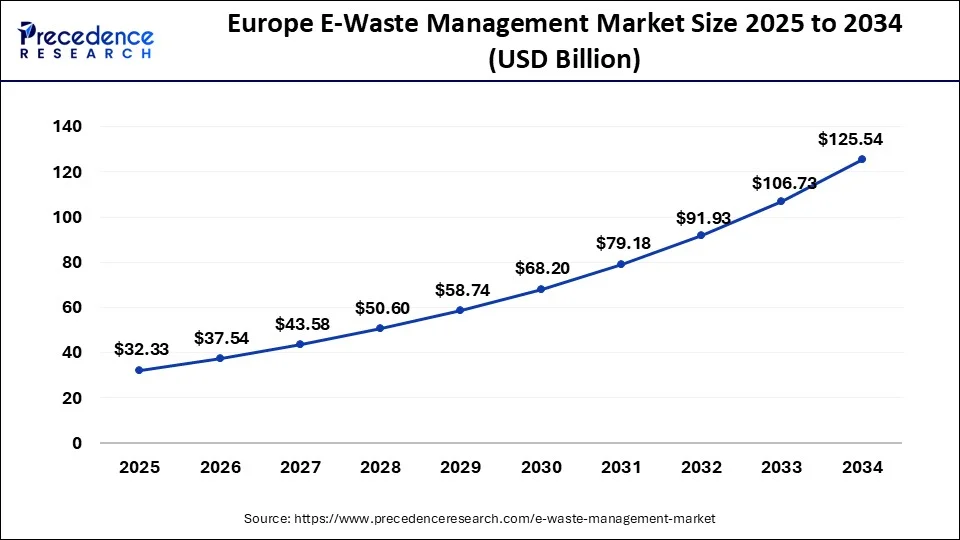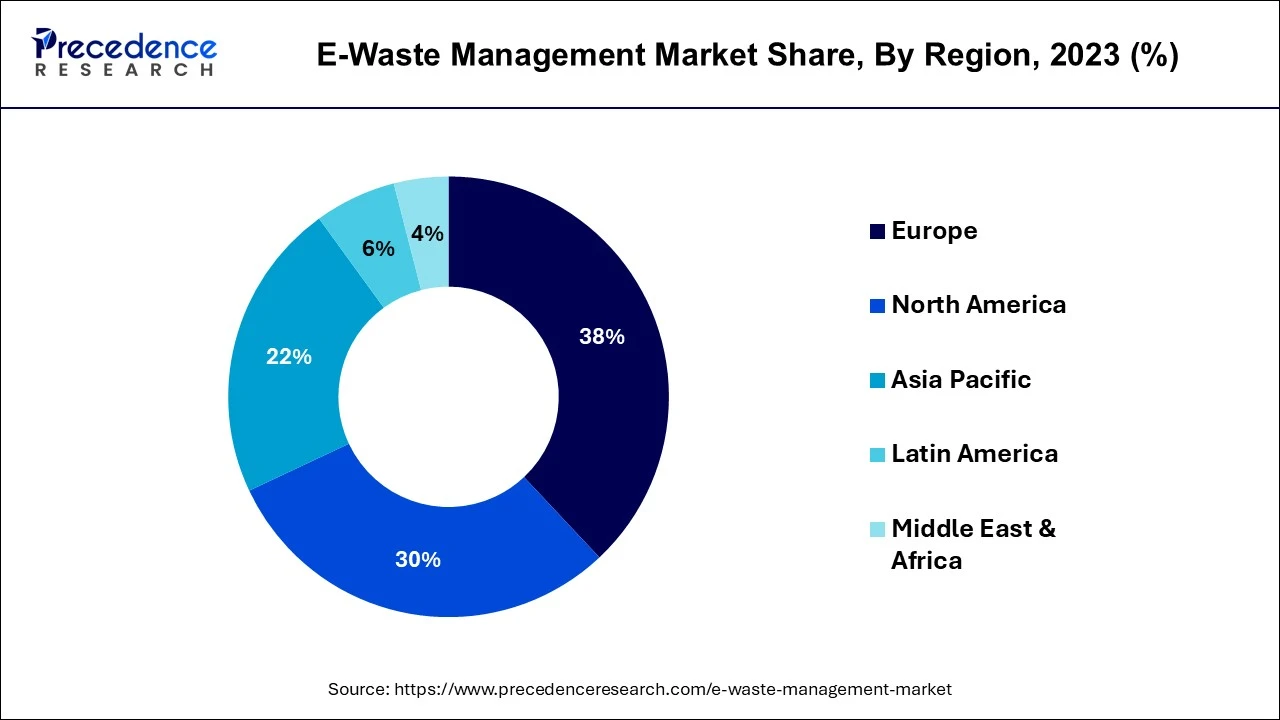What is the E-Waste Management Market Size?
The global E-waste management market size is calculated at USD 85.08 billion in 2025 and is predicted to increase from USD 98.78 billion in 2026 to approximately USD 326.08 billion by 2034, expanding at a CAGR of 16.10% from 2025 to 2034.The global E-waste management market growth is attributed to the rapid pace of technological advancements.

E-Waste Management Market Key Takeaways
- Europe contributed more than 38% of the revenue share in 2024.
- Asia Pacific is estimated to expand the fastest CAGR between 2025 and 2034.
- By application, the trashed segment has held the largest market share of 59% in 2024.
- By application, the recycled segment is anticipated to grow at a remarkable CAGR of 18.1% between 2025 and 2034.
- By material type, the metal segment generated over 47% of revenue share in 2024.
- By material type, the plastic segment is expected to expand at the fastest CAGR over the projected period.
- By source type, the consumer appliance segment had the largest market share of 42% in 2024.
- By source type, the household appliance segment is expected to expand at the fastest CAGR over the projected period.
- By recycler type, the metal recycler segment generated over 49% of revenue share in 2024.
- By recycler type, the plastic recycler segment is expected to expand at the fastest CAGR over the projected period.
Market Overview
The E-waste management market pertains to the structured management and disposal of electronic waste, encompassing discarded electrical and electronic devices. This market addresses the burgeoning issue of electronic waste, ensuring its environmentally responsible disposal, recycling, or refurbishment. With the rapid obsolescence of electronic devices and the global surge in electronic consumption, the demand for effective e-waste management is rising.
This market addresses ecological concerns, promotes recycling, and ensures the safe handling of hazardous materials found in electronic waste. It aligns with the global shift toward sustainable practices, environmental regulations, and the efficient use of resources.
E-Waste Management Market Outlook
- Industry Growth Overview: The e-waste management market is projected for substantial growth between 2025 and 2034, driven by the escalating volume of discarded electronic devices, rapid technological obsolescence, and increasing industrial automation, along with recycling and recovery of valuable metals, IT and telecom equipment disposal services, and management of electric vehicle (EV) batteries.
- Sustainability Trends: This trend involves the use of advanced material recovery techniques such as hydrometallurgy and urban mining, energy-efficient recycling hardware, and the development of eco-friendly, modular electronic product designs, ensuring data security during disposal and formalizing the informal recycling sector for better environmental and health outcomes.
- Global Expansion: Market leaders are expanding their operations globally, with a strong focus on high-e-waste-generating regions such as Asia-Pacific. Expansion is driven by stringent government regulations (EU's WEEE Directive, India's E-Waste Management Rules), public-private partnerships, and investments in local recycling infrastructure across Southeast Asia, Eastern Europe, and Latin America.
- Major Investors: Venture capital (VC) firms, private equity, and strategic corporate investors are actively funding the sector, attracted by strong margins in material recovery and alignment with ESG goals. Companies like Umicore, Sims Limited, and Aurubis AG are major players driving innovation and strategic acquisitions. The European Union, New Enterprise Associates, and impact-focused VCs such as Avaana Capital and Transition VC.
- Startup Ecosystem: The startup ecosystem is thriving with innovation in AI-driven sorting systems, robotics for disassembly, and novel hydrometallurgical processes. Emerging firms like Namo eWaste, Solugen, and Metastable Materials are attracting significant funding by offering scalable, certified, and sustainable alternatives to traditional e-waste processing methods.
E-Waste Management Market Growth Factors
- E-waste management offers opportunities in recycling, refurbishment, materials recovery, and data security services, with the potential for growth in the evolving e-waste market.
- The proliferation of electronic devices and the rapid turnover of tech gadgets fuel the generation of electronic waste, driving the demand for effective e-waste management solutions.
- Stringent environmental regulations and the enforcement of responsible e-waste disposal practices by governments and regulatory bodies are compelling organizations to adopt proper e-waste management.
- Transparent supply chains are becoming a key trend in e-waste management, ensuring that e-waste is handled responsibly at every stage.
- The refurbishment and reuse of electronic devices are emerging trends, reducing e-waste generation and promoting sustainable practices.
- Developing regions with growing electronic consumption offer untapped markets for e-waste management services.
Market Scope
| Report Coverage | Details |
| Growth Rate from 2025 to 2034 | CAGR of 16.10% |
| Market Size in 2025 | USD 85.08 Billion |
| Market Size in 2026 | USD 98.78 Billion |
| Market Size by 2034 | USD 326.08 Billion |
| Largest Market | Europe |
| Base Year | 2024 |
| Forecast Period | 2025 to 2034 |
| Segments Covered | By Application, By Material Type, By Source Type, and By Recycler Type |
| Regions Covered | North America, Europe, Asia-Pacific, Latin America, and Middle East & Africa |
Market Dynamics
Driver
Rapid technological advancements and circular economy initiatives
The E-waste management market is significantly driven by rapid technological advancements and the widespread proliferation of electronic devices. Consequently, there is a substantial increase in electronic waste generation, compelling the need for efficient e-waste management solutions. Consumers and organizations alike are constantly in pursuit of the latest electronic innovations, perpetuating a cycle of device replacement and disposal. This ever-growing stream of discarded electronics underscores the importance of comprehensive e-waste management practices.
Simultaneously, the adoption of circular economy initiatives plays a pivotal role in driving market demand. The global shift towards a circular economy encourages responsible e-waste management practices such as recycling, refurbishment, and materials recovery. Rather than discarding electronic devices as waste, this approach aims to extend their life cycle and extract valuable materials from old gadgets, reducing the environmental impact. With the increasing focus on sustainability and resource conservation, circular economy principles align perfectly with the goals of eco-conscious individuals and businesses, further boosting the demand for professional e-waste management services.
Restraint
Lack of awareness and resource-intensive recycling
Lack of awareness among consumers and businesses about the significance of proper e-waste management acts as a major constraint on the market. Many individuals and organizations lack awareness regarding the environmental and health risks linked to improper electronic waste disposal. The improper disposal of e-waste, including careless dumping in landfills or incineration, has severe consequences, leading to increased pollution and the squandering of valuable resources. To tackle this challenge, extensive awareness campaigns and educational initiatives are essential in promoting responsible e-waste disposal practices and fostering environmental stewardship.
Resource-intensive recycling processes can also deter market demand. E-waste recycling often involves labor-intensive disassembly and the extraction of valuable materials, such as precious metals and rare earth elements, from electronic devices. To address this restraint, innovations in automated and efficient e-waste recycling technologies and increased awareness campaigns are essential to promote responsible e-waste management practices.
Opportunity
Consumer electronics upgrade cycles and global E-waste trade
The market demand for E-waste management is significantly surged by consumer electronics upgrade cycles. As consumers continuously seek the latest technological advancements, electronic devices become obsolete at an accelerated pace. This phenomenon, known as planned obsolescence, fuels the generation of electronic waste. Manufacturers intentionally design products with a limited lifespan to encourage frequent upgrades. As consumers replace their old devices with new ones, the volume of e-waste increases.
Global E-waste trade is another crucial factor propelling market demand. With the globalization of electronics manufacturing, there's a thriving global trade of electronic components and devices. The global trade of e-waste can lead to environmental and health hazards in the countries that receive these materials. Growing awareness of the negative consequences of unregulated e-waste disposal is leading to increased demand for international e-waste management practices.
Segments Insight
Application Insights
The trashed segment has held 59% revenue share in 2024. In the E-waste management market, the segment signifies electronic waste that is improperly discarded, leading to potential environmental and health hazards. This often includes electronic items that end up in landfills or are incinerated, highlighting the urgent need for proper disposal methods and responsible recycling.

The recycled segment is anticipated to expand at a significant CAGR of 18.1% during the projected period. Recycled e-waste refers to electronic devices and components collected and processed through recycling methods, contributing to resource conservation and reduced environmental impacts. A growing trend in this market is the emphasis on sustainable e-waste management practices, fostering responsible disposal, and recycling efforts to minimize the environmental footprint.
Material Type Insights
The metal segment held largest market share of 47% in 2024. In the E-waste management market, metal refers to the category of electronic waste materials composed primarily of various metals, including aluminum, copper, and gold, which can be extracted and recycled. Trends in metal e-waste management involve increasing recycling efforts to recover valuable metals. Additionally, the rising use of eco-friendly and energy-efficient electronic products reduces the need for mining new metals, making metal recycling a more sustainable practice.
On the other hand, the plastic segment is projected to grow at the fastest rate over the projected period. The plastic category pertains to electronic waste materials that consist mainly of plastic components. A prevalent trend in plastic e-waste management is the development of efficient methods for recycling plastics found in electronic devices, contributing to reduced plastic waste and environmental conservation. The market is witnessing innovations in plastic recycling technologies, enabling the responsible handling of electronic products containing plastic elements.
Source Type Insights
In 2024, the consumer electronics segment had the highest market share of 42% on the basis of the source type. Consumer electronics cover a wide range of personal devices like smartphones, laptops, and tablets. E-waste management in this category focuses on increasing recycling rates, promoting eco-friendly design and materials, and creating collection programs for obsolete devices. A trend includes extended producer responsibility (EPR) programs that shift the burden of e-waste management from consumers to manufacturers, ensuring proper disposal and recycling practices for consumer electronics.
Additionally, initiatives for promoting trade-in and buy-back schemes encourage consumers to return old electronics for recycling and upgrade to newer, more sustainable models. These trends aim to reduce the electronic waste footprint and create a more circular economy for consumer electronics.
The household appliances segment is anticipated to expand at the fastest rate over the projected period. Household appliances encompass electronic devices used in homes, such as refrigerators, washing machines, and microwaves. In the E-waste management market, the recycling and responsible disposal of these appliances are becoming more prevalent. Sustainable trends include refurbishing and reusing appliances, extracting valuable metals and components for recycling, and complying with stricter regulations for handling hazardous materials within appliances. These trends aim to minimize the environmental impact of discarded household appliances.
Recycler Type Insights
In 2024, the metal recyclers segment had the highest market share of 49% on the basis of the recycler type. Metal recyclers in the E-waste management market specialize in processing discarded electronic devices to recover valuable metals such as copper, gold, and aluminum. These recyclers use advanced techniques like shredding and smelting to extract metals from electronic waste. The trend in this sector is a rising demand for efficient and environmentally responsible metal recycling to reduce the environmental impact of e-waste.
The plastic recyclers segment is anticipated to expand at the fastest rate over the projected period. Plastic recyclers in the E-waste management market focus on the reclamation and recycling of plastics from discarded electronic products. They employ methods like mechanical recycling, which involves sorting, shredding, and reusing plastics. The trend in plastic recycling centers on the increased emphasis on reusing plastic components from electronic waste to minimize waste and promote sustainability.
Regional Insights
Europe E-Waste Management Market Size and Growth 2025 To 2034
The Europe e-waste management market size is estimated at USD 32.33 billion in 2025 and is expected to be worth aropund USD 123.91 billion by 2034, growing at a CAGR of 16.25% from 2025 to 2034.

Europe has held the largest revenue share of 38% in 2024. In Europe, the E-waste management market is experiencing significant growth driven by stringent regulations and environmental awareness. The European Union's stringent e-waste directives have prompted responsible disposal practices and increased recycling efforts. Circular economy initiatives encourage the refurbishment and reutilization of electronic devices, reducing electronic waste. The region also witnesses a surge in e-waste collection and recycling facilities, promoting a sustainable approach to e-waste management.
Europe dominated the E-waste management market in 2024. The market growth in the region is driven by factors such as the growing e-waste management industry, increasing consumer trends towards regulatory compliance and sustainability, and increasing use of electronic devices. In Europe, e-waste is the fastest growing waste stream and less than 40% is recycled.
The Circular WEEE Platform has been launched to enhance the collection and recycling of WEEE across Europe, in a significant stride toward sustainable waste management. The aim behind this was to streamline e-waste disposal processes.
Germany E-Waste Management Market Trends
Germany leads the market in Europe. The country operates under the ElektroG, which transposes the EU WEEE Directive into national law, requiring consumers to return e-waste to designated collection facilities. Home to major recycling technology companies, Germany emphasizes advanced sorting and material recovery processes and promotes circular economy initiatives like repair and reuse to maximize

Asia-Pacific is estimated to observe the fastest expansion. The region grapples with mounting e-waste challenges due to increasing electronic consumption. However, it's also witnessing remarkable developments in e-waste management. Several countries have introduced e-waste legislation to regulate disposal. China is adopting extended producer responsibility (EPR) mechanisms, encouraging manufacturers to take responsibility for their products' entire life cycle. India's e-waste management and handling rules are steering the region toward better e-waste management. Asia-Pacific experiences growth in recycling plants and informal sector involvement in e-waste recycling, contributing to sustainable practices.
How Asia Pacific Revolutionize E-Waste Management Market Trends
Asia Pacific is expected to grow fastest during the forecast period. The market growth in the region is attributed to the increasing exposure and awareness to proper recycling and waste disposal, and increasing sales of electronic products, such as household appliances, computers, and smartphones. China, India, Japan and South Korea are the fastest growing countries.
For instance, in September 2024, OPPO India and All-India Council for Technical Education (AICTE) launched the 'Generation Green' campaign with a nationwide electronic-waste awareness drive (e-waste). The aim behind this launch was to inspire and empower the youth to champion sustainability efforts through green skills and corrective actions.
India E-Waste Management Market Trends
In India, the market is expanding quickly. India is the third-largest e-waste producer in the world, fueled by rapid industrial growth. The market in India is mostly characterized by a large informal sector that manages over 90% of the waste using dangerous methods. The Indian government is working to formalize the industry through the E-Waste (Management) Rules of 2016, which require Extended Producer Responsibility for manufacturers and create effective, official collection systems to encourage safer processing.
How is the Opportunistic Rise of North America in the E-Waste Management Market?
North America plays an evolving role in the global market, driven by high electronics consumption and strong regulations. The region produces large amounts of e-waste and boosts demand for advanced recycling solutions to recover valuable materials. State-level regulations and Extended Producer Responsibility (EPR) programs encourage manufacturers to adopt responsible management practices. The market benefits from innovations in advanced sorting technologies and the presence of major, technologically skilled waste management companies.
U.S. E-Waste Management Market Trends
The U.S. is the leading force in the North American market. Without a single federal law, many states have put in place strict regulations and mandatory recycling programs. Major companies like Waste Management, ERI, and Sims Limited stand out by providing comprehensive services such as secure data destruction, IT asset disposition, and environmentally friendly recycling processes, thereby meeting strong commercial and residential demands.
What Opportunities Exist in Latin America for the Growth of the E-Waste Management Market?
Latin America presents significant opportunities for market growth due to increasing consumption of electronic devices and growing environmental awareness. However, the region faces challenges like inadequate infrastructure and low formal collection rates, leading to a large portion of waste being mismanaged. Governments are implementing new regulatory frameworks, including Extended Producer Responsibility (EPR) systems and national plans, to formalize the sector, attract investment, and recover valuable materials such as gold, copper, and rare earth elements.
Brazil E-Waste Management Market Trends
Brazil is the largest producer of e-waste in Latin America and a key player in the regional market. The country has established a National Policy on Solid Waste and a formal reverse logistics system for e-waste, promoting shared responsibility among stakeholders. Despite this regulatory framework and the increasing number of collection points, formal recycling rates remain low, with the informal sector playing a major role in dismantling e-waste by developing advanced, capital-intensive processing facilities.
What Potentiates the Growth of the E-Waste Management Market in the Middle East and Africa?
The market in the Middle East and Africa (MEA) is driven by rapid urbanization and digitization. The region is focusing on building strong waste management systems, with more investments in waste-to-energy projects and modern recycling facilities. Countries like the UAE and South Africa are leading with national strategies and public-private partnerships (PPPs) to tackle challenges related to poor infrastructure and high per capita waste generation.
Saudi Arabia E-Waste Management Market Trends
Saudi Arabia is the largest consumer of electronics and the leading producer of e-waste among Arab states. The country's Vision 2030 initiative, which focuses on sustainability and a circular economy, is a key driver for the waste management sector. The government, through the National Center for Waste Management (MWAN), is attracting private investment and establishing a new legal framework to develop modern recycling facilities
Value Chain Analysis
- E-Waste Collection and Sorting
This stage involves gathering discarded electronics and performing initial sorting.
Key Players: Best Buy, ERI, FedEx, and UPS. - Transportation and Logistics
This stage involves safe and compliant movement of e-waste to facilities.
Key Players: Specialized haulers, 3PL providers like DHL, DB Schenker. - Dismantling and Manual Segregation
This stage involves manual disassembly of e-waste into basic components (circuit boards, plastics, metals, batteries).
Key Players: Sims Lifecycle Services, ERI, WM, Goodwill, Salvation Army.
Mechanical Processing and Material Separation
This stage involves automated shredding and sorting of remaining components using specialized machinery.
Key Players: Umicore, Boliden, WM, Republic Services. - Material Recovery and Refining
This stage involves purification and refining of recovered materials (precious and base metals).
Key Players: Refiners like Umicore, Aurubis, and Materion. - End-of-Life Product Remarketing and Refurbishment
Testing, repairing, and reselling viable devices to extend their lifecycle.
Key Players: Arrow Electronics, TechSoup, Gazelle, Back Market, Amazon Renewed. - Final Disposal and Compliance Reporting
Proper disposal of non-recyclable or hazardous residues and managing regulatory reporting.
Key Players: Veolia, Clean Harbors, EPA (Environmental Protection Agency).
Top Companies for the E-Waste Management Market and Their Offerings
- Sims Limited: Global IT asset disposition and electronics recycling, focusing on data centers.
- Umicore: Advanced metallurgical recovery of valuable metals from complex e-waste materials.
- Electronic Recyclers International (ERI):Large U.S.-based e-waste recycler focusing on secure data destruction and ITAD.
- Aurubis AG:Major copper recycler processing e-waste to reclaim copper and other metals via smelters.
- Global Electric Electronic Processing Inc. (GEEP): End-to-end ITAD, data destruction, and demanufacturing of e-waste.
Other Key Players
- MBA Polymers, Inc.
- Stena Metall AB
- Waste Management, Inc.
- Enviro-Hub Holdings Ltd.
- Lifespan Technology Recycling, Inc.
- Cimelia Resource Recovery
- Electronic Waste Management
- Eco-Tech Environmental Services
- Tetronics (International) Ltd.
- CRT Recycling Ltd.
Recent Developments
- In November 2024, Japan-based global financial institution Sumitomo Mitsui Banking Corporation (SMBC) launched a pioneering e-waste management program in the Delhi-NCR region. The aim behind this launch was to establish sustainable practices that can be replicated across the country.
- In March 2024, the Government announced the launch of a novel platform for trading e-waste responsibility certificates. The aim behind this launch was to tackle the growing problem of electronic waste (e-waste) by promoting proper recycling practices.
- In 2022,ERI, an e-waste management company, collaborated with Call2Recycle and CellBlock FCS to introduce OneDrum, an innovative battery collection solution. OneDrum allows customers to conveniently collect and transport large volumes of consumer batteries, eliminating the need for separate categorization by chemistry or individual bagging of battery terminals.
- In 2022, ERI, a prominent cybersecurity and electronics hardware destruction company, partnered with Redrock Environmental Group to offer residents in Madera County an environmentally responsible means of recycling unwanted consumer electronics.
- In 2022, TES, an IT Asset Disposal and e-waste firm, has divested its European trade operations focusing on e-scrap recycling to align with extended manufacturer responsibility programs.
Segments Covered in the Report
By Application
- Trashed
- Recycled
By Material Type
- Metal
- Plastic
- Glass
- Others
By Source Type
- Household Appliance
- Consumer Electronics
- Industrial Electronics
- Others
By Recycler Type
- Glass Recycler
- Metal Recycler
- Plastic Recycler
- Printed Circuit Board Recycler
- Others
By Geography
- North America
- Europe
- Asia-Pacific
- Latin America
- Middle East and Africa
 Get a Sample
Get a Sample
 Table Of Content
Table Of Content



